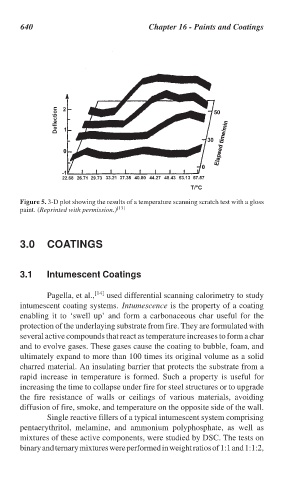Page 672 - Handbook of Thermal Analysis of Construction Materials
P. 672
640 Chapter 16 - Paints and Coatings
Figure 5. 3-D plot showing the results of a temperature scanning scratch test with a gloss
paint. (Reprinted with permission.) [13]
3.0 COATINGS
3.1 Intumescent Coatings
Pagella, et al., [14] used differential scanning calorimetry to study
intumescent coating systems. Intumescence is the property of a coating
enabling it to ‘swell up’ and form a carbonaceous char useful for the
protection of the underlaying substrate from fire. They are formulated with
several active compounds that react as temperature increases to form a char
and to evolve gases. These gases cause the coating to bubble, foam, and
ultimately expand to more than 100 times its original volume as a solid
charred material. An insulating barrier that protects the substrate from a
rapid increase in temperature is formed. Such a property is useful for
increasing the time to collapse under fire for steel structures or to upgrade
the fire resistance of walls or ceilings of various materials, avoiding
diffusion of fire, smoke, and temperature on the opposite side of the wall.
Single reactive fillers of a typical intumescent system comprising
pentaerythritol, melamine, and ammonium polyphosphate, as well as
mixtures of these active components, were studied by DSC. The tests on
binary and ternary mixtures were performed in weight ratios of 1:1 and 1:1:2,

